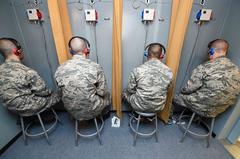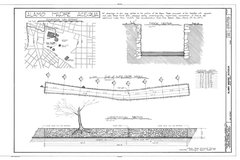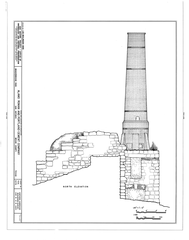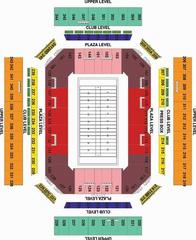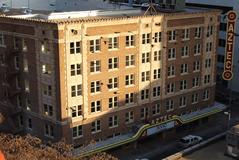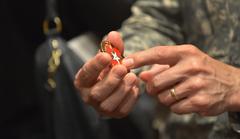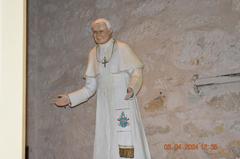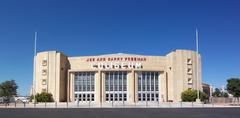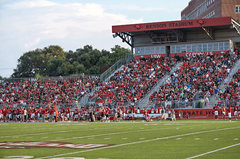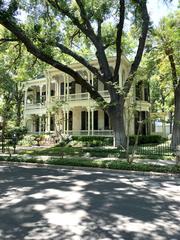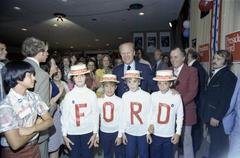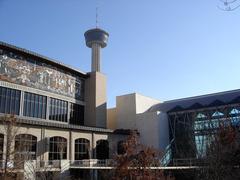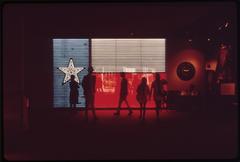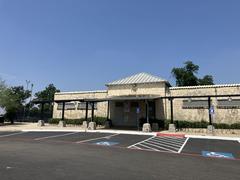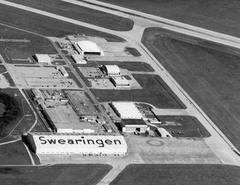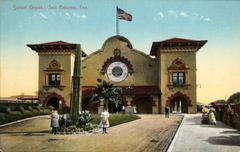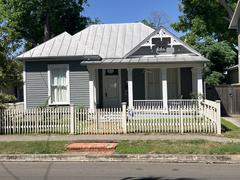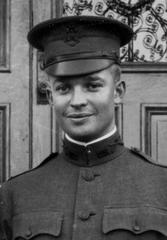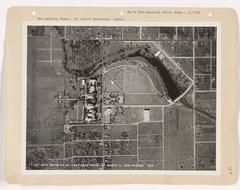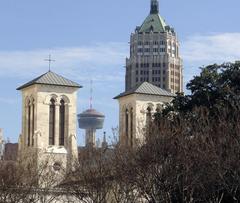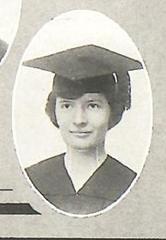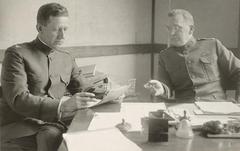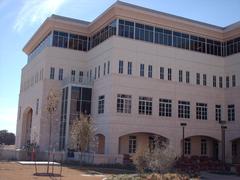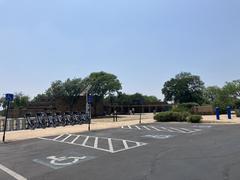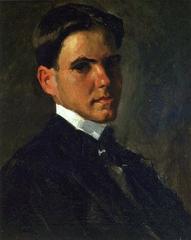German-English School San Antonio: Visitor Guide, History, and Architectural Significance
Date: 14/06/2025
Introduction
The German-English School in San Antonio is a cornerstone of the city’s multicultural identity and a vivid reminder of the German immigrants’ influence in Texas. Founded in 1858 by the “Forty-Eighters,” German immigrants who championed secular, bilingual education, the school reflects San Antonio’s dynamic blend of German and Texan heritage. Today, this historic landmark continues to celebrate its roots through festivals, language camps, and public programs, while serving as a tangible link to the evolution of bilingual education and progressive ideals in Texas.
This comprehensive guide provides detailed information on the school’s history, significance, architectural features, visiting hours, ticketing, accessibility, and nearby attractions—ensuring visitors can make the most of their experience.
For further context and updates, consult resources such as Texas Time Travel, the San Antonio Report, and the German-Texan Heritage Society.
Table of Contents
- Introduction
- Historical Context and Founding
- Educational Philosophy and Community Role
- Social and Political Legacy
- Visiting the German-English School
- Guided Tours and Special Events
- Architectural Features and Preservation
- Nearby Attractions and Visitor Amenities
- Frequently Asked Questions (FAQ)
- Plan Your Visit and Further Resources
- References
Historical Context and Founding
Early German Immigration and Community Formation
San Antonio became a focal point for German immigrants in the 1840s and 1850s. The failed 1848 revolutions in Europe drove political refugees known as the “Forty-Eighters” to Texas, where they established thriving communities. By the late 1850s, Germans made up approximately a third of Bexar County’s population, maintaining German as a prominent language alongside English and Spanish.
Establishment and Mission
Founded in 1858, the German-English School emerged from this burgeoning community’s desire to preserve its language and culture. The school was notable for its secular, bilingual curriculum—a rarity at the time—designed to foster both German identity and integration into American society. Julius Berends, a pioneering educator, played a significant role in shaping the school’s academic rigor and progressive values.
Educational Philosophy and Community Role
Rejecting religious instruction, the school emphasized free, secular education in both German and English. The curriculum included mathematics, science, literature, history, music, and moral education, equipping students for life within both the German community and the broader Texan society.
The school also served as a cultural nucleus, organizing clubs, festivals, and language programs that reinforced community bonds and kept German traditions alive. Its graduates were often bilingual and played key roles in San Antonio’s civic, business, and cultural life.
Social and Political Legacy
The German-English School reflected the liberal and reformist outlook of its founders. The German community in San Antonio was distinguished by its opposition to slavery and support for abolition, which led to both influence and tension in 19th-century Texas. German-language newspapers and public debates further established the community as a progressive force in the region.
However, during World War I, anti-German sentiment and English-only laws curtailed the use of German in schools and public life, challenging the survival of institutions like the German-English School. Nevertheless, its legacy laid the groundwork for bilingual education in Texas and preserved the unique Texas German dialect.
Visiting the German-English School
Location and Setting
The school is located at 423 S. Alamo Street, in the heart of San Antonio’s historic La Villita district. It stands between the Marriott Plaza San Antonio hotel and the La Villita Arts Village, facing Yanaguana Garden in Hemisfair Park. The site is pedestrian-friendly and easily accessible from the River Walk, the Alamo, and the King William Historic District (San Antonio Report).
Visiting Hours and Admission
- Current Status: The German-English School is undergoing rehabilitation as part of a larger development project. As a result, there are no fixed visiting hours, and access to some areas may be temporarily restricted.
- Courtyard Access: The outdoor courtyard and some exterior features are generally open to the public during daylight hours, free of charge.
- Tickets: There is no admission fee to visit the grounds. Guided tours and interior access may be arranged by appointment or during special community events.
- Updates: For the latest information, check with the German-Texan Heritage Society or La Villita Historic Arts Village.
Accessibility
- The district offers smooth pathways suitable for wheelchairs and strollers, though some historic interiors may have limited accessibility.
- Public restrooms, seating, and parking are available throughout the La Villita area.
- Public transit via VIA Metropolitan Transit provides easy access.
Guided Tours and Special Events
While regular guided tours are temporarily suspended due to ongoing renovations, the German-English School is often featured in walking tours of La Villita. On-site interpretive signage and historical photographs offer valuable self-guided experiences.
The school continues to host cultural programming, such as weekend German language immersion camps for children, organized by the German-Texan Heritage Society. These programs foster linguistic and cultural appreciation for younger generations.
During festival periods and community events, visitors can participate in heritage celebrations, educational workshops, and seasonal festivities that reflect the vibrant German-Texan culture.
Architectural Features and Preservation
German-Texan Vernacular Architecture
The German-English School exemplifies German-Texan vernacular architecture, blending locally quarried limestone and brick with practical, elegant design. Key features include:
- Thick stone walls for durability and insulation
- High ceilings and large windows for natural light and ventilation
- Minimalist facades with restrained ornamentation, reflecting German design sensibilities
- Original woodwork and exposed timber beams, showcasing immigrant craftsmanship
The campus expanded from its original one-story stone building to a two-story brick addition by 1869, accommodating the school’s growth and evolving educational needs (Texas Time Travel; TSHA Handbook).
Preservation Efforts
The site is recognized as a Recorded Texas Historic Landmark, with ongoing preservation overseen by the Conservation Society of San Antonio and the Historic and Design Review Commission. The current rehabilitation project aims to integrate modern amenities while retaining the school’s historic character (San Antonio Report).
Nearby Attractions and Visitor Amenities
La Villita offers artisan shops, galleries, cafes, and cultural venues within walking distance. Other nearby attractions include:
- The Alamo
- San Antonio River Walk
- King William Historic District
- Guenther House
- Spanish Governor’s Palace
Yanaguana Garden and Hemisfair Park provide green spaces and interactive public art, while upcoming dining options will further enhance the visitor experience.
Frequently Asked Questions (FAQ)
Q: What are the German-English School’s visiting hours?
A: The courtyard is generally open during daylight hours. Interior access depends on construction schedules and special events.
Q: Is there an admission fee?
A: Admission to the courtyard and grounds is free.
Q: Are guided tours available?
A: Regular tours are suspended during renovations, but the school is part of many La Villita walking tours.
Q: Is the site wheelchair accessible?
A: The district is largely accessible, though some historic interiors may have limitations.
Q: How can I get to the German-English School?
A: The site is accessible by foot, public transit, or car, with paid parking nearby.
Q: Can I participate in cultural programs or language camps?
A: Yes, contact the German-Texan Heritage Society for details on available programs.
Plan Your Visit and Further Resources
To make the most of your visit:
- Check for updates on visiting hours and events through official sources.
- Download the Audiala app for guided tours, exclusive content, and event notifications.
- Explore virtual tours, images, and maps online to plan your route and interests.
For additional information, see:
- Texas Time Travel
- TSHA Handbook
- San Antonio Report
- German-Texan Heritage Society
- San Antonio Tourism - German Heritage
- Texas Real Food - Legacy of German-Texan Architects and Builders
Summary and Visitor Recommendations
The German-English School in San Antonio is much more than a historical site; it is a living emblem of the city’s German heritage and the pioneering spirit of its immigrant founders. From its innovative educational model and distinctive architecture to its ongoing cultural programs and preservation efforts, the school remains a vibrant part of San Antonio’s story. Visitors are encouraged to explore the grounds, participate in cultural events, and use available resources to deepen their understanding of Texas’s multicultural roots.
For up-to-date visitor details, always check official sources before planning your trip.
References
- German-English School, Texas Time Travel
- German-English School, TSHA Handbook
- German-English School Project, San Antonio Report
- German Texans Heritage Society Summer Camps
- San Antonio Tourism - German Heritage
- Texas Real Food - Legacy of German-Texan Architects and Builders
